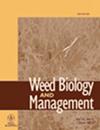Chemical and environmental factors driving germination of Solanum americanum seeds
IF 1.5
4区 农林科学
Q3 AGRONOMY
引用次数: 4
Abstract
Solanum americanum Mill. is a weed that occurs with a number of crops, and it is known for its high seed production and its staggered germination. The objective of this work was to evaluate the germination behavior of S. americanum seeds under the influence of chemical and environmental factors. In the laboratory, we tested the effect on germination of (i) constant and alternating temperatures, (ii) seed washing, (iii) exposure time and concentration of chemical treatments and (iv) seeding depth and soil covered with plant residue on seedling emergence. The variables analyzed were germination percentage, germination rate index, seedling emergence and length of the seedlings. The results indicated that alternating temperatures are the main way to promote germination of S. americanum; however, chemical treatments can help to increase the germination percentage and rate index. There was no increase in germination with seed washing, with the exception of KNO₃ application. A GA₃ concentration of 0.84 g L⁻¹ and an exposure time of 21.22 h in 0.2% of KNO₃ promoted the highest germination of S. americanum. Germination occurs when seeds remain on the soil surface and are not covered by crop residue.促使美洲茄种子发芽的化学和环境因素
美洲龙葵是一种与许多作物一起生长的杂草,以其高种子产量和交错发芽而闻名。本研究的目的是评价化学和环境因素对美洲藜种子萌发行为的影响。在实验室中,我们测试了(i)恒定温度和交替温度对发芽的影响,(ii)种子清洗,(iii)化学处理的暴露时间和浓度,(iv)播种深度和覆盖植物残留物的土壤对幼苗出苗的影响。分析的变量包括发芽率、发芽率指数、出苗率和幼苗长度。结果表明,交变温度是促进美洲葡萄发芽的主要途径;而化学处理能提高发芽率和发芽率指数。除了使用KNO₃外,洗籽没有增加发芽率。在0.2%的KNO₃中,GA₃的浓度为0.84 g L⁻¹,暴露时间为21.22 h,促进了美洲葡萄的最高发芽率。当种子停留在土壤表面而没有被作物残留物覆盖时,萌发就发生了。
本文章由计算机程序翻译,如有差异,请以英文原文为准。
求助全文
约1分钟内获得全文
求助全文
来源期刊

Weed Biology and Management
农林科学-农艺学
CiteScore
2.70
自引率
0.00%
发文量
13
审稿时长
>36 weeks
期刊介绍:
Weed Biology and Management is an international journal, published four times per year. The journal accepts contributions in the form of original research and review articles in all aspects of weed science. Contributions from weed scientists in the Asia–Pacific region are particularly welcomed.
The content of the contributions may relate to weed taxonomy, ecology and physiology, weed management and control methodologies, herbicide behaviors in plants, soils and environment, utilization of weeds and other aspects of weed science. All contributions must be of sufficient quality to extend our knowledge in weed science.
 求助内容:
求助内容: 应助结果提醒方式:
应助结果提醒方式:


